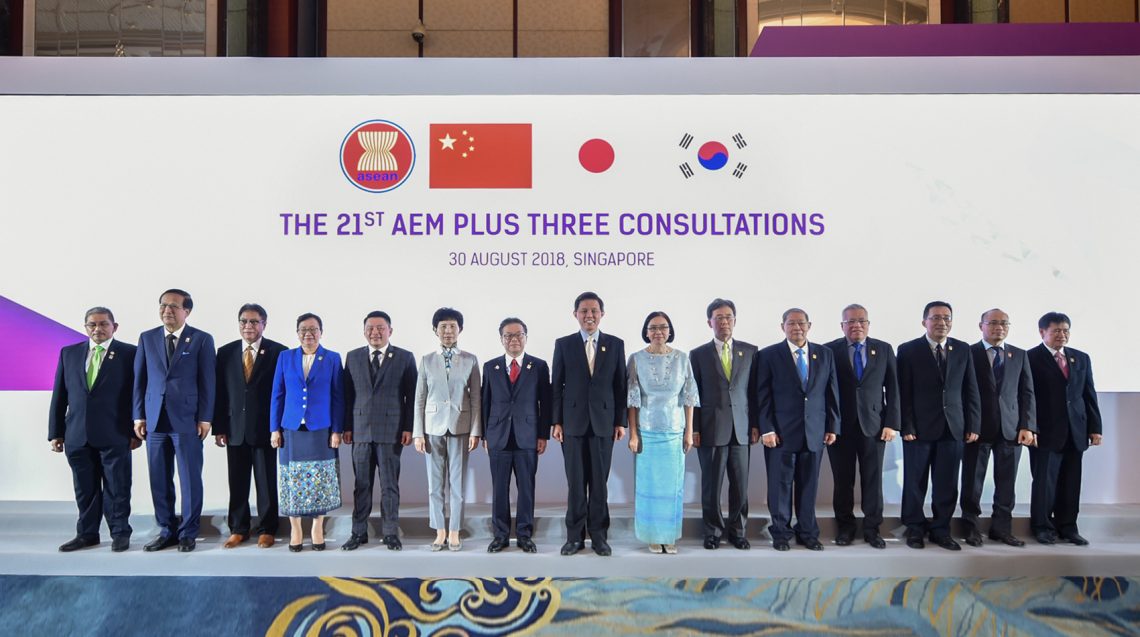1. Economic Ministers from the ten ASEAN Member States, People’s Republic of China (“China”), Japan and Republic of Korea (“Korea”) met on 30 August 2018 in Singapore for the Twenty-First AEM Plus Three Consultations. The Consultations were co-chaired by H.E. Chan Chun Sing, Minister for Trade and Industry, Singapore, H.E. Mdm. Gao Yan, Vice Minister of Commerce, the People’s Republic of China (representing H.E. Zhong Shan, Minister of Commerce, the People’s Republic of China), H.E. Hiroshige Seko, Minister of Economy, Trade and Industry, Japan, and H.E. Kim Hyun-chong, Minister for Trade, Korea.
2. The Ministers welcomed the strong global economic growth of 3.7 per cent in 2017, with its positive impact on trade and investment growth. This was reflected in stronger trade growth between ASEAN and the Plus Three Countries in 2017. Total trade increased by 16.1 per cent to USD 807.3 billion, representing 31.6 per cent of ASEAN’s total merchandise trade. Foreign Direct Investment (FDI) flows from the Plus Three Countries into ASEAN were valued at USD 29.9 billion in 2017, accounting for 21.8 per cent of total FDI inflows into ASEAN.
Download the full Statement here.
Download the opening remarks here.
- ABOUT ASEANThe Association of Southeast Asian Nations, or ASEAN, was established on 8 August 1967 in Bangkok, Thailand, with the signing of the ASEAN Declaration (Bangkok Declaration) by the Founding Fathers of ASEAN: Indonesia, Malaysia, Philippines, Singapore and Thailand. Brunei Darussalam joined ASEAN on 7 January 1984, followed by Viet Nam on 28 July 1995, Lao PDR and Myanmar on 23 July 1997, and Cambodia on 30 April 1999, making up what is today the ten Member States of ASEAN.Menu
- WHAT WE DO
ASEAN organs always strive to achieve ASEAN’s goals and objectives, the Secretary-General of ASEAN and the ASEAN Secretariat shall be functioned as coordinating Secretariat to help facilitate effective decision-making withing and amongst ASEAN bodies. In addition, each Member State shall appoint a Permanent Representative to liaise with Secretary-General of ASEAN and the ASEAN Secretariat
Menu - WHO WE WORK WITH
ASEAN shall develop friendly relations and mutually beneficial dialogues, cooperation and partnerships with countries and sub-regional, regional and international organisations and institutions. This includes external partners, ASEAN entities, human rights bodies, non-ASEAN Member States Ambassadors to ASEAN, ASEAN committees in third countries and international organisations, as well as international / regional organisations.
Menu - OUR COMMUNITIES
The rodmap for an ASEAN Community (2009-2015) was declared by the leaders in 2009. The ASEAN Community, anchored on three community pillars: Political-Security Community, Economic Community, Socio-Cultural Community was launched in 2015. The ASEAN 2025: Forging Ahead Together was introduced in 2015 as a Post-2015 Vision. It comprises the ASEAN Community Vision 2025, the ASEAN Political-Security Community Blueprint 2025, the ASEAN Economic Community Blueprint 2025 and the ASEAN Socio-Cultural Community Blueprint 2025
Menu - SITEMAP





